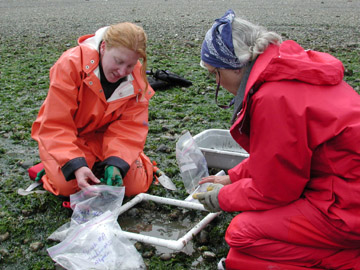|
|
We
have drawn on an extensive, multi-year database of
biota and physical characteristics of 64 sites in Puget
Sound to choose the appropriate study sites and generalize
our results. All experiments are conducted at 3 replicate
beaches with shared geophysical characteristics.

|
|
Juvenile
Pacific oysters are settled on ceramic tiles in the laboratory
and outplanted to each of the 9 experimental beaches, where
the tiles are attached to stakes pounded into the sediment.
Plates are photographed every 1-2 months and the growth
rates of individual oysters are measured from these photographs.
The plates also serve as ways to measure natural colonization
of other organisms. After approximately 6 months, oysters
are sampled for stable isotope analysis. Link
to Findings. |
|
|
Barnacle
larvae are allowed to settle on tiles placed in one location
(at the Friday Harbor Labs on San Juan Island), then
tiles are moved to the experimental beaches and attached
to stakes as for the oyster tiles. Barnacle growth is
similarly measured from photographs taken every month
through the year. Other organisms settling on the barnacle
tiles are also quantified.
Link to Findings. |
|
|
Small,
waterproof temperature dataloggers (TidbiTs, Onset Computer
Corporation) are placed at each of the 9 beaches and
programmed to log the temperature approximately once
every hour. At each beach, separate loggers record the
temperature on the surface of the beach (same tidal level
as the experiments), buried in the sediment of the beach,
and just offshore of the beach. These data are used
to seek correlations between local processes (growth
rates, distinct recruitment or mortality events) and
temperature, and also to quantify how well nearshore
temperatures track those recorded in the middle of Puget
Sound by other research groups (e.g. Washington Department
of Ecology). Link
to Findings. |
|
Rocks
with small individuals of the common brown seaweed Fucus
gardneri (rockweed) were placed at each of the 9 sites
in June 2004, and all the individual plants were marked
and measured. Plants are remeasured monthly, and their
growth rates compared among sites. This provides a measure
of primary productivity.
Link to Findings. |
|
To
measure the recruitment of organisms (especially juvenile
clams and worms) settling in beach sediments, cores of
sterile sediment enclosed in window-screening were
embedded in each beach beginning in Feb. 2005. These
cores were exchanged with new ones each month, so
that we could examine seasonal patterns in recruitment
as well as patterns along the north-south gradient.
Link to Findings. |
|
|
To
measure the recruitment of organisms that live on surfaces
(e.g. on natural cobbles), we put out ceramic settling
tiles at each beach beginning in Feb. 2005. These were
exchanged with clean ones each month, as with the sediment.
Link to Findings. |
|
|
Basic
information on the abundance and diversity of
organisms on each beach are gathered each
year at each of the experimental sites. Sampling follows
the
protocol used by DNR’s
SCALE program. Briefly, a 50m line is laid along
the beach at 0' tide level. At 10 randomly placed intervals,
all the macroscopic organisms on the surface are counted
using a 50x50cm quadrat frame, and all the organisms
are sieved from a sediment core 15cm deep and 10cm diameter,
and identified later in the laboratory. |
|
To measure predation on juvenile organisms settling in
beach sediments 'clam tubes' with and without
net coverings were embedded at each beach.
The tubes were constructed of PVC and filled
with cores of sterile sediment to allow natural
recruitment to occur. They were deloyed from May through
September 2006. |
 |
At
5 additional locations in June of each year, all organisms
are collected from the surface and from a sediment core
to measure biomasses. Species-specific
biomasses are measured by randomly collecting samples of epibiota
and large infauna (clams) and returning them to the lab to get
wet and dry masses; small infauna biomasses are measured
following laboratory identification.
Link to Findings.
|

